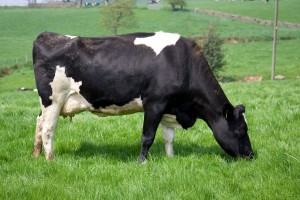The first time I drove through Vermont, every road felt picturesque. Rust-colored barns, grain silos and animals grazing in the grassy pastures reminded me of the classic American farm consistently depicted in paintings, films and other media. I’d like to believe all livestock lived on farms like the one I saw and had a similar diet, but unfortunately I know that’s not the reality.
The majority of cattle raised for meat and milk production is kept in feedlots and receive grain instead of grass for sustenance. While this alteration might seem like an inconsequential change-up, it can actually impact the nutritional benefits, quality of life for the animal and the final product.
According to the Washington Post, cows fed exclusively grass will have higher concentrations of vitamins A and E and contain less fat. In fact, omega-3 levels will be almost 50 percent higher in grass-fed beef.
The same holds true for milk. “Grass-only” and organic milk also have higher levels of omega-3s and the market has been steadily growing for it—despite its greater price tag.
“Grass-only” milk, the cows receive an almost exclusively grass diet, and in order for milk to receive a USDA certified organic label, the cows must get least 30 percent of their diet from grass and graze for more than 120 days a year in a pasture.
If you are a beef-eater, the taste of exclusively grass-fed meat may be better too. Some have said it can be chewier, but it will maintain a superior flavor compared to other types of grain fed cows.
The taste and added nutrients aren’t the only benefits from a grassier diet. If animals, like cows, are fed too much seed they will become sick and require antibiotics, according to Michael Polan. Low-dose antibiotics used in feed to ward off infection can lead to antibiotic resistant bacteria and substantial public health issues.
There is, however, some debate over whether or not a feed-based diet is better for the planet. Beef production all in all is not environmentally friendly. In the United States about 30 million cattle were slaughtered in 2014 alone, and raising those cows creates a substantial amount of methane.
Some argue raising cows in feedlots allows can help manage the methane, but it’s unclear if it actually makes a substantial difference in the environment. Either way, the best way to help the environment would be to consumer less animal products altogether. There may also be some health benefits associated with a diet with more veggies and less meat.
Overall, it’s almost no question that eating a healthier diet makes us healthier, so why shouldn’t the same hold true for cows? If a diet of too much grain and seeds can make cows and can even make them sick, shouldn’t that be a red flag for a consumer? To me, paying the premium for grass fed is worth it.

I appreciated this overview, Diana. The cases of cows, chickens, and pigs raised by industrial methods definitely illustrate Pollan’s notion of “food that good to think.” One side of this is the cruelty of such confined and dosed-up meat production, which takes one’s appetite away. Less obvious but also highly significant is the factor you focus on here. Namely, that it makes a difference to our own health what such animals are fed–both the grain that replaces a healthier grass-diet for cows and the antibiotics necessary to rear livestock in crowded quarters and eating too much corn.
I look forward to being in dialogue with you in the class this summer.
John